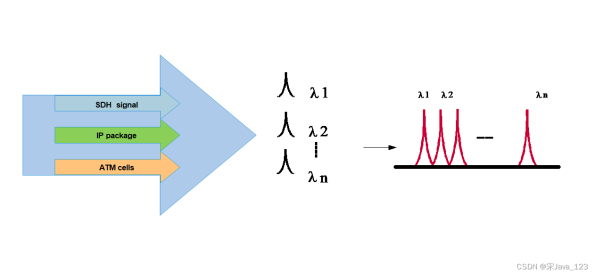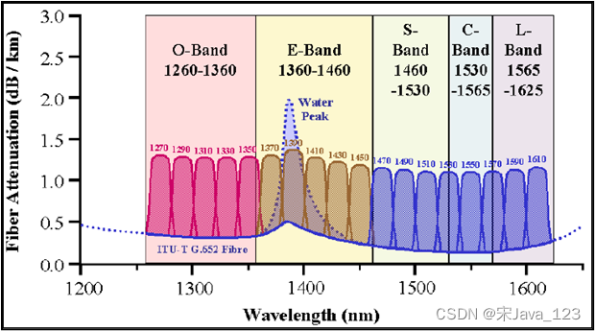Overview of WDM refers to Wavelength Division Multiplexing, or wavelength division multiplexing technology. It is a technology that uses optical signals of different wavelengths to transmit multiple signals in the same optical fiber. In simple terms, WDM technology is to transmit multiple signals to the destination through optical signals of different wavelengths, thereby realizing high-speed and large-capacity optical communication. In a WDM system, each wavelength can be regarded as an independent channel. WDM technology is one of the basic technologies widely used in modern optical communication networks. It can improve the speed, capacity and reliability of optical communication. This example is commonly used in multiplexing to intuitively show the working mode of WDM.

Three optical fiber communication transmission technologies: SDM, TDM and WDM
Since WDM is mentioned, SDM and TDM have to be mentioned. Here, SDM and TDM can be simply understood. SDM, TDM, and WDM are three different fiber optic communication transmission technologies, which respectively stand for Space Division Multiplexing, Time Division Multiplexing, and Wavelength Division Multiplexing.
1. SDM (Space Division Multiplexing): It is a technology that uses different optical modes in the optical fiber to transmit multiple signals. For example, multiple signals can be transmitted to the same optical fiber by transmitting multiple optical modes at the same time or by assigning different wavelengths of light to different modes.
2. TDM (Time Division Multiplexing): It is a technology that transmits multiple signals in the same optical fiber by transmitting different signals in time sequence. In TDM, each signal occupies a fiber optic time interval, and these signals do not overlap in time, so that each signal can be correctly separated at the receiving end.
3. WDM (Wavelength Division Multiplexing): It is a technology that transmits multiple signals in the same optical fiber by transmitting optical signals of different wavelengths into the same optical fiber. In WDM, each signal occupies a fiber optic time interval, and these wavelengths do not overlap in the optical fiber, so that each signal can be correctly separated at the receiving end.
Wavelength interval of WDM wavelength division multiplexing The wavelength ranges commonly used in wavelength division multiplexing technology include:
1. CWDM wavelength range: CWDM refers to “Coarse Wavelength Division Multiplexing“, i.e. coarse wavelength division multiplexing (sparse wavelength division multiplexing). In CWDM, the wavelength interval is usually 2, covering the wavelength range of 1270-1610 nanometers.
2. DWDM wavelength range: DWDM refers to “Dense Wavelength Division Multiplexing“, i.e. dense wavelength division multiplexing. In DWDM, the wavelength interval is usually 0.8 nanometers or less, covering the wavelength range of C band (1530-1565 nanometers) and L band (1565-1625 nanometers).

The frequency range of C band is 4GHz to 8GHz, so its average frequency is (4GHz + 8GHz)/2 = 6GHz. According to the formula that wave speed is equal to frequency multiplied by wavelength, the wavelength of C wave can be calculated: Wave speed = frequency × wavelength Therefore, wavelength = wave speed ÷ frequency According to the internationally accepted wave speed value of 299,792,458 m/s (i.e., the speed of light), convert the frequency into Hertz (Hz) and the wavelength into centimeters (cm): Average wavelength = Speed of light ÷ Average frequency = 299,792,458 m/s ÷ 6 GHz = 0.049965 cm = 0.49965 mm Therefore, the number of 160 wavelengths in the C band is: 160 = (7.5 cm – 3.75 cm) / 0.049965 cm Extended C band can provide more wavelengths and frequency bands, which enables DWDM technology to achieve higher channel density and higher bandwidth capacity in the C band. By using DWDM technology, different signals can be transmitted on different wavelengths, so that one optical fiber can transmit more signals, which improves the transmission efficiency and reliability of fiber communication. Extended C band refers to the expansion of the C band (the frequency band used for satellite communications and other communication applications) from the original 160 wavelengths to 192 wavelengths. This means that within the original C-band spectrum, 32 wavelengths have been added. Therefore, the key to expanding the C-band is to add 32 wavelengths, and each wavelength is smaller, which helps improve communication quality and reliability. At the same time, GHz as a frequency unit can also be used to describe the frequency range of the C-band. Here we mention the WDM application part – OTN optical transport network (Optical Transport Network). In the optical transport network (OTN), DWDM (Dense Wavelength Division Multiplexing) technology is used to achieve high-speed data transmission by simultaneously transmitting optical signals of multiple wavelengths on a single optical fiber. Among them, each wavelength is usually called a “channel”, or a “wavelength”. In DWDM systems, wavelengths in the C wave (1525~1565nm) are usually densely wavelength-division multiplexed to achieve higher bandwidth utilization. Under , the wavelengths in these C bands are usually divided into 80 equally spaced wavelength intervals (each interval is 0.8nm), so they are usually called “80 waves”, while the extended C band has 192, and there are actually 96 available waves in OTN, which is also the latest application. Therefore, there is a direct relationship between the 80 waves in the OTN application and the 160 waves in the C band, because these Selected from the C-band, each wavelength interval is 0.8nm, a total of 80. At the same time, it should be noted that the C-band contains more wavelengths (or more channels), not just 8 3. LWDM wavelength range: LWDM refers to “Long Wavelength Division Multiplexing”, that is, long wavelength wavelength division multiplexing. In LWDM, the wavelength interval is usually 2 nanometers, covering the wavelength range of 1620 nanometers, which is used to transmit multiple signals in the PON network.
3. Supplement: SWDM (Short Wavelength Division Multiplexing) is a short-wavelength wavelength division multiplexing technology used to achieve high-speed data transmission based on existing multimode optical fibers. SW uses two wavelengths of 850 nanometers and 940 nanometers to transmit different data streams respectively, which can achieve a transmission rate of up to 40Gbps based on existing multimode optical fibers. The wavelength range used by SWDM is 850 nanometers and 940 nanometers, which does not belong to the wavelength range used by traditional CWDM and DWDM technologies. However, SWDM is also a wavelength division multiplexing technology, so it can be regarded as a variant of WDM technology.










